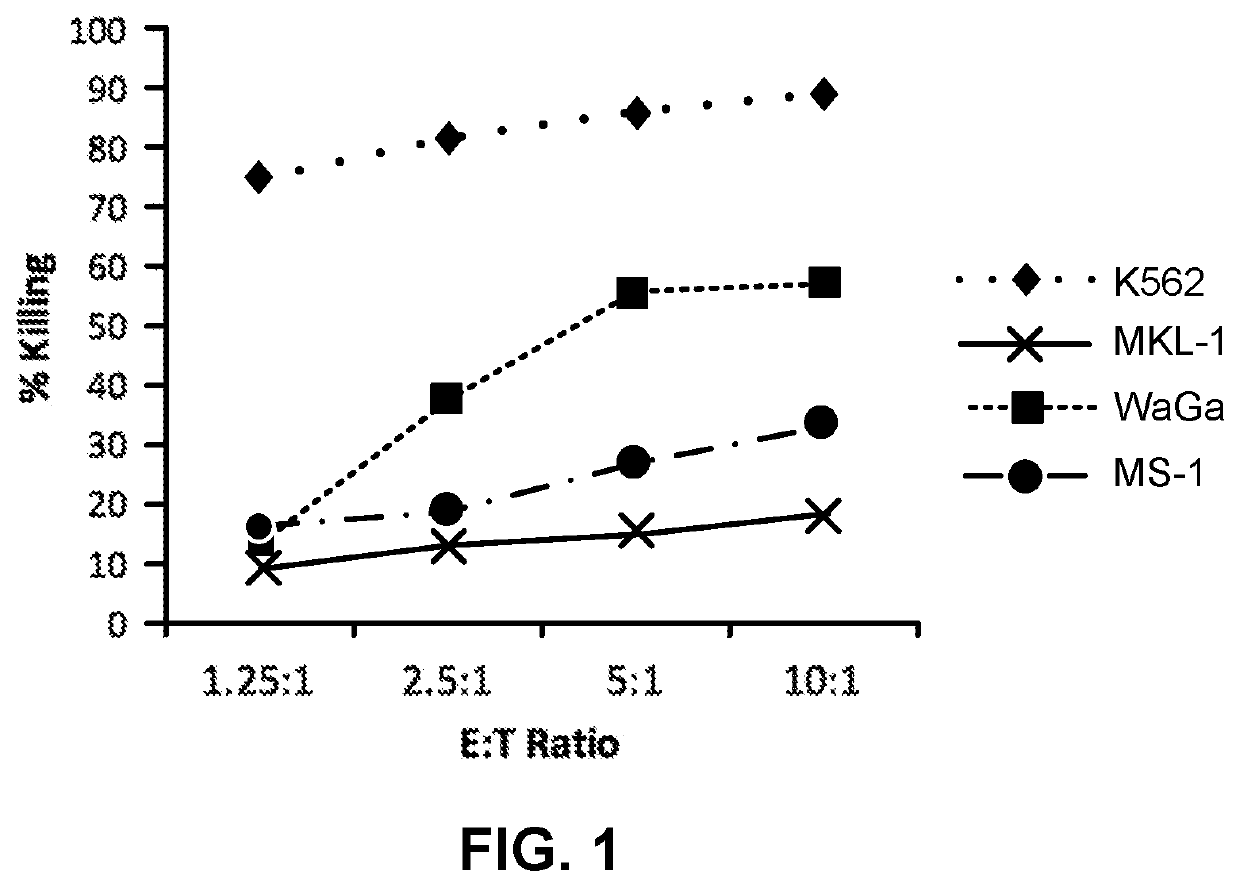Methods for treating merkel cell carcinoma (MCC) using nk-92 cells
a technology of merkel cell carcinoma and nk92 cells, which is applied in the direction of mammal material medical ingredients, antineoplastic agents, medical preparations, etc., can solve the problems of limited data to guide treatment decisions regarding chemotherapy and radiotherapy, and the response is rarely durabl
- Summary
- Abstract
- Description
- Claims
- Application Information
AI Technical Summary
Benefits of technology
Problems solved by technology
Method used
Image
Examples
example 1
Cytotoxic Activity of NK-92 Cells Against Polyomavirus-Positive Merkel Cell Carcinoma Cell Lines
[0044]NK-92 cells demonstrate cytotoxic activity towards polyomavirus-positive MCC cell lines. FIGS. 1 and 2 show the results of NK-92 cell cytotoxicity after overnight exposure of NK-92 cells to three MCC cell lines (MKL-1, WaGa and MS-1) at different effector to target ratios. K562, a human CML cell line serves as a control, as it is consistently killed by NK-92 cells. Specifically, K562, MKL-1, MS-1, and WaGa cells (targets) were pre-stained with the membrane dye PKH67-GL, according to the manufacturer's instructions (Sigma Aldrich, St. Louis, Mo.), and resuspended in RPMI 1640+10% FBS at a cell density of 10e5 / ml. NK-92 cells (effectors) were resuspended in X-Vivo10+5% HS+IL-2 (500 IU / ml) at a cell density of 10e6 / ml. Target and effector cells were mixed in a 96-well plate at effector to target (E:T) ratios of 10:1, 5:1, 2.5:1, 1.25:1 in final volume of 200 ul / well. Targets alone cont...
example 2
Treatment of Merkel Cell Carcinoma (MCC) In Vivo Using NK-92 Cells
[0045]An 81 year old male patient with recurrent progressive MCC on the scalp with at least three cutaneous metastases was treated with NK-92 cells. Prior therapies had included surgery, adjuvant radiation (RT), intralesional interferon (IFN) plus RT plus topical imiquimod, anti-PD-1 therapy, intralesional TLR-4 agonist, RT with neutrons and octreotide-long-acting release (LAR). Patient received, in the first cycle on day 1, an NK-92 intravenous infusion of 2×109 cells / m2. On day 2 of the first cycle, patient received a second NK-92 infusion of 2×109 cells / m2. The cycle was repeated eight times with two week intervals between each cycle. The patient achieved a complete response (CR) with full resolution of the MCC tumors. The NK-92 therapy was tolerated with no significant adverse events.
[0046]A 75 year old male with progressive MCC on the thigh was treated with NK-92 cells. Prior therapies had included chemotherapy a...
example 3
Treatment of MCC Patients
[0047]Three patients were treated with NK-92 cells. These patients all had unresectable stage III (IIIB) or distant metastatic (stage IV) MCC based on Response Evaluation Criteria in Solid Tumors (RECIST). NK-92 cells were given to patients via IV infusion at a dose of 2×10e9 cells / m2 on two consecutive days (=1 cycle) every 2 weeks for a total of 8 cycles (16 infusions). Patients were monitored and Progression Free Survival was assessed at 4 months from initiation of the treatment. The preliminary data showed that the NK-92 cell therapy achieved beneficial clinical results.
PUM
 Login to View More
Login to View More Abstract
Description
Claims
Application Information
 Login to View More
Login to View More - R&D
- Intellectual Property
- Life Sciences
- Materials
- Tech Scout
- Unparalleled Data Quality
- Higher Quality Content
- 60% Fewer Hallucinations
Browse by: Latest US Patents, China's latest patents, Technical Efficacy Thesaurus, Application Domain, Technology Topic, Popular Technical Reports.
© 2025 PatSnap. All rights reserved.Legal|Privacy policy|Modern Slavery Act Transparency Statement|Sitemap|About US| Contact US: help@patsnap.com


